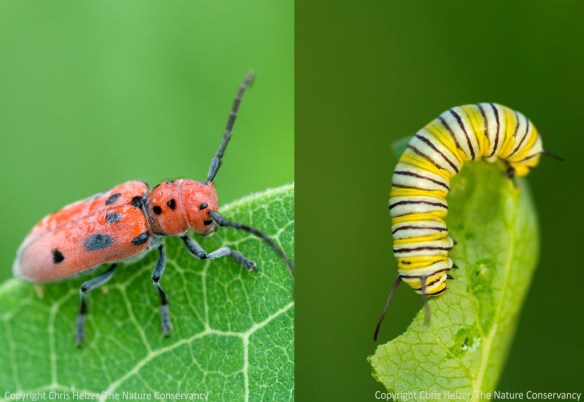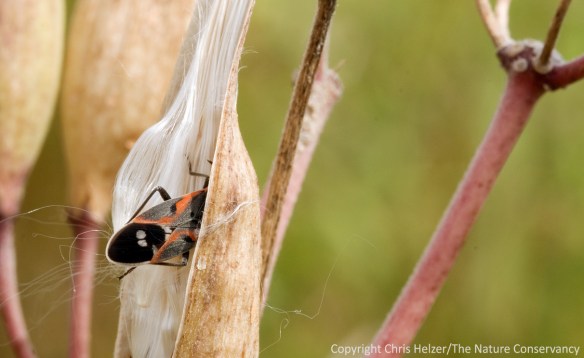Not many insects can feed on milkweed. Milkweed plants produce a toxin that disables a protein in animals – a protein that facilitates important functions such as muscle contraction. Only a small number of insect species around the world have evolved ways to get around this challenge.
A new study published in the journal Science looked at 14 insect species that feed on milkweed and found that each had developed one of two ways to solve the milkweed toxin challenge. Ten of the insect species had gone through a genetic mutation that changed the protein in a way that the prevented the toxin from being able to act on it. The other four species had created a duplicate gene in the protein that allowed it to both carry out its normal function and alter itself to avoid being impacted by the toxin. You can see a summary of the study and a link to the full article here.
What’s most fascinating is that while these insects are only very distantly related to each other (they spanned three different orders of insects) they ended up with the same solutions to the milkweed toxin issue. It’s not like one insect species millions of years ago developed in a way that made it immune to milkweed toxin and then begat other species of insects that retained the same quality. These insects each developed the immunity INDEPENDENTLY. Fantastic.

The red milkweed beetle (left) and the monarch butterfly caterpillar (right) are not closely related insects. However, both have independently evolved the same ability to feed on milkweed plants without ill effects.
Now, I have to be careful when talking about evolution because it’s easy to give the impression that these insects did something purposeful to change their bodies – they didn’t. They changed because natural selection favored individuals with certain genetic mutations that allowed them to eat milkweed without suffering changes to essential proteins. Unfortunately, evolution can be a hot-button topic these days, and one of the biggest reasons is that many people have a fundamental misunderstanding of how evolution actually works. If you’re interested, here is a link to website with a very brief but clear explanation of the process.
In the case of milkweed-eating insects, it’s easy to see that being able to eat a plant that competing herbivores can’t eat is a major advantage. Somewhere in history, a few lucky individuals ended up with a random genetic mutation that allowed them to eat milkweed without ill effects. Those individuals got a sudden leg up on their competition and, as a result, were more likely to survive and reproduce. What’s crazy and fun in this case is that multiple unrelated species ended up with similar genetic mutations of their proteins. They each accidentally “found” the same path to success. It’s a great world we live in.


Amazing shots.
I would suspect that the mutations involved must be relatively common among insects, but lacking selective value in non-milkweed feeders, repeatedly get lost, as well. I mention this because lack of understanding of the both the frequency and randomness of mutations is part of the difficulty that people have with grasping evolution. Stated otherwise, mutations – (usually) small but effective changes in DNA in individuals – occur all the time, but if they’re not helpful to the survival of the individuals in which they occur, these genetic novelties are not passed on, and neither increase nor spread through the population. If conditions change, and the genetic change becomes favorable, it will become more prevalent through the generations.
A good point, and well stated.
Thank you Chris! I’m all about anything milkweed related, but this post’s links will help me do battle, pro milkweed and natural selection whenever I give talks. How’s the prairie looking this year?
Our prairies are looking just fine. Very dry and short in some places, dry and tall in others. Not as flowery as some years, but very interesting.
Here the selective pressure for the insect to develop a way to bypass the milkweed’s chemical defense appears to be stronger than the selective pressure for the milkweed to develop a chemical defense (all of the insect’s diet vs partial defoliation of a plant) so it is also amazing and wonderful that plants develop defenses too.
Nice post, Chris. It should be mentioned that in one of these groups – milkweed beetles of the genus Tetraopes – the original species actually did “beget” more species to result today’s wonderful diversity of species, all utilizing various species of milkweed.
Nice article. I have been exploring this subject, the origin of milkweeds in Africa, their migration to the Americas and the fauna dependent on milkweeds. It is interesting to mention the milkweed weevil, Rhyssomatus palmacollis, which seems to have adapted more recently to feeding on Asclepias and which has not developed aposematic coloration. There is so much more to learn about this!
Pingback: Diversity, Redundancy, and Resilience | The Prairie Ecologist